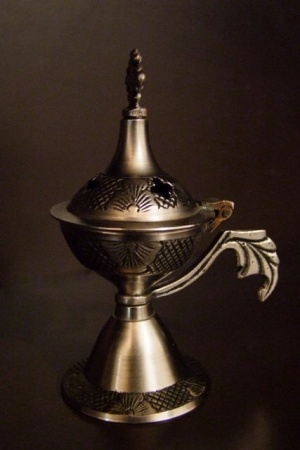A censer[note 1] is a small metal or stone dish used for burning incense. A common design is a metal container, about the size and shape of a small coffee-pot, suspended on chains and often with the addition of small bells. The bowl contains hot coals, and the incense is placed on top of these.
Censers used in the church, known as a thurible in the Western Rite, are used during offices or services, such as Vespers, Orthros, and the Divine Liturgy. Censing is the practice of swinging a censer suspended from chains towards something or someone, typically an icon or person, so that smoke from the burning incense travels in that direction. If a deacon is present, he typically does much of the censing, otherwise the duty is undertaken by the priest. Unordained servers or acolytes are permitted to prepare and carry the censer, but may not swing it during prayers.
When the temple (church building) is censed, the priest or deacon will move in a sunwise (clockwise) direction, moving to his right as he censes in order the Holy Table (altar), sanctuary, Iconostasis, walls of the temple, clergy and faithful. There are two types of censing: a Greater Censing (which encompasses the entire temple and all of the people therein), and a Lesser Censing (which, depending upon the liturgical context, consists of censing only a portion of the temple and the people).
During some censings, especially the Greater Censing, the clergyman who is performing the censing will often carry a candle in his left hand. During Bright Week (the week which begins on Easter Sunday) the priest and the deacon will carry special Paschal candles at every censing, even the Lesser Censing. While carrying the Paschal candles, the priest or deacon will greet the members of the congregation with the Paschal greeting while censing them. Simple candles are carried while censing during funerals and memorial services.
Theological significance
To the Orthodox, burning incense represents the prayers of the faithful rising towards Heaven as a sweet smelling spiritual fragrance. One commonly sung psalm during the censing is "Let my prayer rise like incense before You, the lifting up of my hands like the evening sacrifice." Some Orthodox Christians use a standing censer on their home altars.
The censer used in the liturgical services of the Church contains a bowl/recepticle which represents the Church. Some commentators suggest that this represents the Holy Theotokos because like she contained within her womb the Divine Fire, so too, the censer contains the burning coal of faith.
This dish is supported by four chains each of which carries three bells. The twelve bells represent the voices of the disciples proclaiming the Gospel based on the teachings of the four Evangelists here represented by the chains. The three outer chains attached to the bowl are for the Holy Trinity, and the fourth inner chain attached to the lid is for the Oneness of God.
In addition, the censer used is often gold plated, combining in itself at the offering of incense the three gifts of the Biblical Magi: gold, frankincense, and myrrh.
Notes
- ↑ (Greek)
- Θυμιατο, Thymiato.
- Кадилница, Kadilnitsa.
- Θυμιατο, Thymiato.

